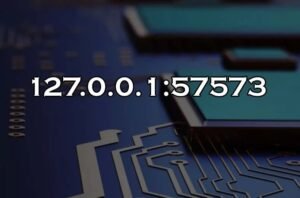
127.0.0.1:49342
The address 127.0.0.1:49342 may seem complex and technical, but it plays a crucial role in the functioning of modern networks and systems. This article dives deep into what this address represents, its significance in networking, and how it is used in various applications. We aim to provide a detailed understanding that will help both beginners and professionals navigate this essential aspect of computing.
What is 127.0.0.1?
127.0.0.1 is commonly known as the localhost or loopback address in the world of networking. It is a special IP address that computers use to refer to themselves. When you connect to 127.0.0.1, you are essentially connecting to your computer. This address is reserved for internal testing and communications within a host and cannot be used to connect to other computers over a network.
The Significance of the Loopback Address
The loopback address is a crucial tool for developers and system administrators. It allows for the testing of network applications and services locally, without the need for a physical network connection. By using 127.0.0.1, developers can simulate network connections and troubleshoot issues in a controlled environment. This process is essential for the development of reliable and secure applications.
Understanding Port 49342
The port number 49342 is a unique identifier that allows different applications and services to coexist on the same IP address. In networking, a port number is used to direct traffic to the correct service running on a server. Port numbers range from 0 to 65535, and each is associated with a specific service or application.
Dynamic and Private Ports
Port numbers above 49151 are classified as dynamic or private ports. These ports are not officially assigned to any specific service and are typically used for temporary or custom applications. Port 49342 falls within this range, making it a dynamic port likely used for a temporary connection in a particular application or service.
How Port 49342 is Utilized
When you see 127.0.0.1:49342 in your system’s network activity, it usually indicates that an application is using this port for local communication. This setup is common in situations where a program needs to send data to itself or between different components on the same machine. This port can be assigned dynamically by the system when an application requests a connection, and it is usually released once the application no longer needs it.
The Role of Localhost in Web Development
Localhost is a critical element in web development. Developers often use 127.0.0.1 to host websites and applications on their local machines for testing before deploying them to a live server. This method allows developers to make changes, test new features, and debug issues without affecting a live environment.
Testing with Localhost
Using 127.0.0.1 enables developers to create a local development environment that mirrors a production server. This approach is invaluable for ensuring that applications run smoothly in real-world conditions. By testing on localhost, developers can identify and fix bugs, optimize performance, and ensure compatibility across different systems.
Security Considerations
While 127.0.0.1 is confined to local traffic and is generally secure, developers must be cautious when configuring applications. Misconfigurations or vulnerabilities in the software can still lead to security issues, even in a local environment. Therefore, it is essential to follow best practices in application security, even when working with local hosts.
Common Applications Using 127.0.0.1:49342
Several common applications and services might use the address 127.0.0.1:49342 during their operation. Understanding these applications can help in diagnosing network issues and optimizing system performance.
Web Servers and Databases
Local development servers, such as Apache or Nginx, often use 127.0.0.1 to host websites during development. Similarly, databases like MySQL or PostgreSQL may use a local host address to manage data transactions securely on the same machine.
Development Tools
Integrated Development Environments (IDEs) and other development tools might use dynamic ports for debugging or live-reloading of applications. For instance, when you run a Node.js application in a local environment, it might bind to 127.0.0.1:49342 for debugging purposes.
Game Servers
Some multiplayer games or game development environments might also use 127.0.0.1 and dynamic ports like 49342 to host local game servers or simulate networked gameplay during development.
Troubleshooting Issues with 127.0.0.1:49342
Occasionally, you may encounter issues when working with 127.0.0.1:49342. Understanding how to troubleshoot these problems can save time and prevent disruptions in your workflow.
Port Conflicts
One common issue is a port conflict, where multiple applications attempt to use the same port simultaneously. If another application is already using port 49342, your application may fail to bind to this port, resulting in errors. To resolve this, you can either configure your application to use a different port or close the application currently using 49342.
Firewall and Security Settings
Firewalls and security software may block traffic to and from 127.0.0.1, especially on specific ports like 49342. Ensure that your firewall settings allow traffic on the necessary ports for your applications to function correctly.
Checking Active Connections
To diagnose issues, you can use tools like netstat or lsof to view active connections and see which ports are in use. This information can help identify the source of conflicts or confirm that your application is correctly listening on 127.0.0.1:49342.

Conclusion
The address 127.0.0.1:49342 may seem like a small detail in the vast world of networking, but it is an essential component for developers and system administrators. Understanding how 127.0.0.1 and port 49342 function together enables efficient troubleshooting, secure development, and effective system management. By mastering these concepts, you can enhance your technical expertise and ensure your applications run smoothly.
Frequently Asked Questions (FAQs)
1. What is 127.0.0.1?
- 127.0.0.1 is the loopback Internet Protocol (IP) address also known as localhost. It is used to establish an IP connection to the same machine or computer being used by the end-user.
2. Why is 127.0.0.1 referred to as localhost?
- Localhost refers to the current device used to access the network. It allows the computer to communicate with itself and is used for testing and development purposes.
3. What does the port number 49342 signify?
- The port number 49342 is a randomly assigned port used for a specific process or service on the local machine. Ports range from 0 to 65535 and are used to distinguish different services or applications running on the same device.
4. How is 127.0.0.1:49342 used in practice?
- This address and port combination can be used by developers to run and test web applications on their local machines. By accessing 127.0.0.1:49342 in a web browser, they can interact with the application as if it were hosted on a remote server.
5. Is 127.0.0.1:49342 accessible from other devices?
- No, 127.0.0.1:49342 is only accessible from the local machine. This loopback address cannot be accessed from external devices over a network.
6. Can 127.0.0.1:49342 be used for remote access?
- No, since 127.0.0.1 points to the local machine, it cannot be used for remote access. To access a machine remotely, you would use the machine’s actual IP address, not the loopback address.
Related Post: 127.0.0.1:57573







